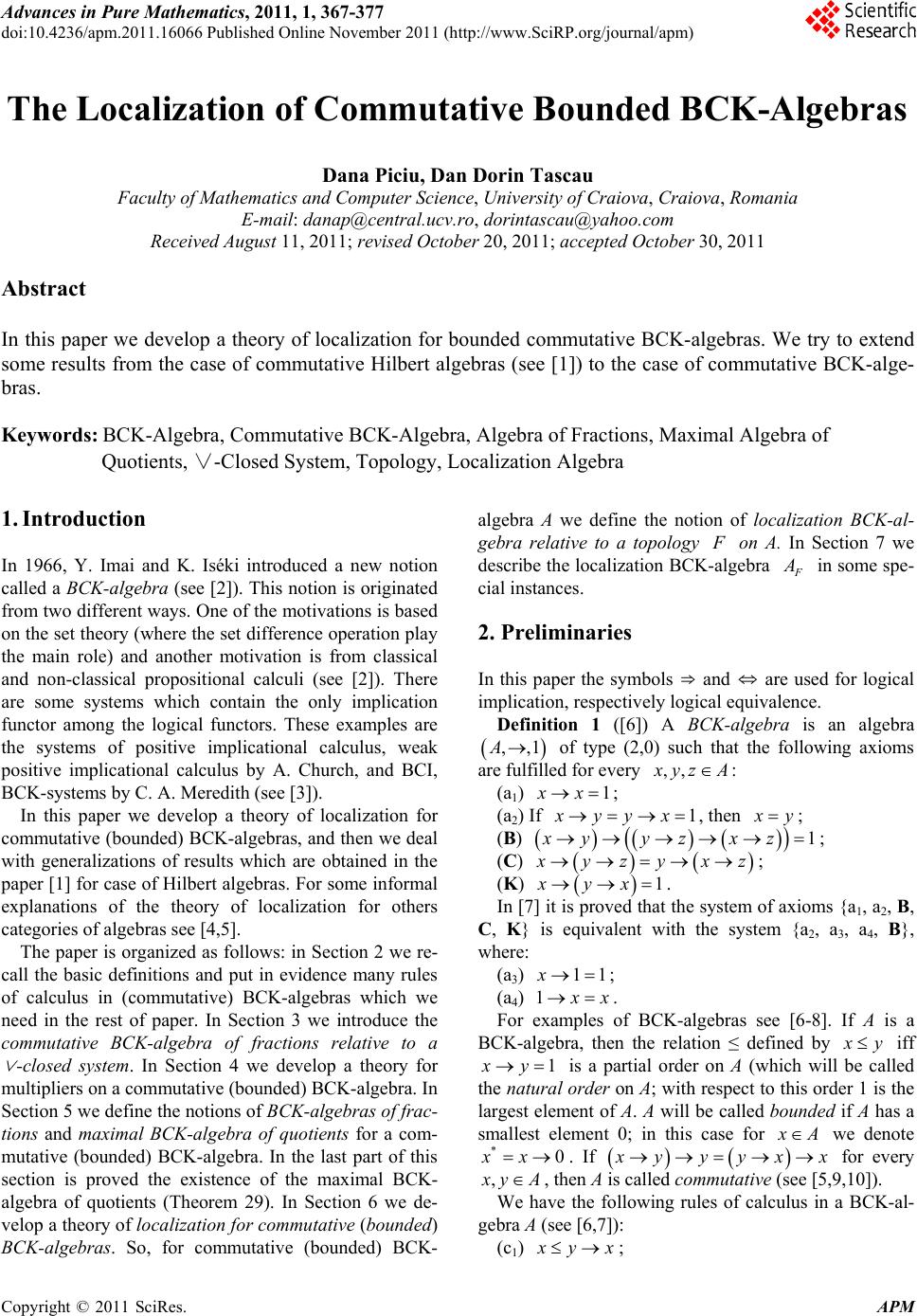 Advances in Pure Mathematics, 2011, 1, 367-377 doi:10.4236/apm.2011.16066 Published Online November 2011 (http://www.SciRP.org/journal/apm) Copyright © 2011 SciRes. APM The Localization of Commutative Bounded BCK-Algebras Dana Piciu, Dan Dorin Tascau Faculty of Mathematics and Computer Science, University of Craiova, Craiova, Rom ania E-mail: danap@central.ucv.ro, dorintascau@yahoo.com Received August 11, 2011; revised October 20, 2011; accepted October 30, 2011 Abstract In this paper we develop a theory of localization for bounded commutative BCK-algebras. We try to extend some results from the case of commutative Hilbert algebras (see [1]) to the case of commutative BCK-alge- bras. Keywords: BCK-Algebra, Commutative BCK-Algebra, Algebra of Fractions, Maximal Algebra of Quotients, ∨-Closed System, Topology, Localization Algebra 1. Introduction In 1966, Y. Imai and K. Iséki introduced a new notion called a BCK-algebra (see [2]). This notion is originated from two different ways. One of the motivations is based on the set theory (where the set difference operation play the main role) and another motivation is from classical and non-classical propositional calculi (see [2]). There are some systems which contain the only implication functor among the logical functors. These examples are the systems of positive implicational calculus, weak positive implicational calculus by A. Church, and BCI, BCK-systems by C. A. Meredith (see [3]). In this paper we develop a theory of localization for commutative (bounded) BCK-algebras, and then we deal with generalizations of results which are obtained in the paper [1] for case of Hilbert algebras. For some informal explanations of the theory of localization for others categories of algebras see [4,5]. The paper is organized as follows: in Section 2 we re- call the basic definitions and put in evidence many rules of calculus in (commutative) BCK-algebras which we need in the rest of paper. In Section 3 we introduce the commutative BCK-algebra of fractions relative to a ∨ -closed system. In Section 4 we develop a theory for multipliers on a commutative (bounded) BCK-algebra. In Section 5 we define the notions of BCK-algebras of frac- tions and maximal BCK-algebra of quotients for a com- mutative (bounded) BCK-algebra. In the last part of this section is proved the existence of the maximal BCK- algebra of quotients (Theorem 29). In Section 6 we de- velop a theory of localization for commu tative (bounded) BCK-algebras. So, for commutative (bounded) BCK- algebra A we define the notion of localization BCK-al- gebra relative to a topology on A. In Section 7 we describe the localization BCK-algebra in some spe- cial instances. 2. Preliminaries In this paper the symbols ⇒ and ⇔ are used for logical implication, respectively logical equivalence. Definition 1 ([6]) A BCK-algebra is an algebra ,,1A of type (2,0) such that the following axioms are fulfilled for every ,, yz A: (a1) ; 1xx (a2) If 1 yy x, then y; (B) 1xyyz xz ; (C) yzy xz; (K) 1xyx . In [7] it is proved that the system of axioms {a1, a2, B, C, K} is equivalent with the system {a2, a3, a4, B}, where: (a3) ; 11x (a4) 1 x. For examples of BCK-algebras see [6-8]. If A is a BCK-algebra, then the relation ≤ defined by y iff is a partial order on A (which will be called the natura l order on A; with respect to this order 1 is the largest element of A. A will be called bounded if A has a smallest element 0; in this case for 1xy A we denote *0xx . If yyy xx for every , yA , then A is called commutative (see [5,9,10]). We have the following rules of calculus in a BCK-al- gebra A (see [6,7]): (c1) yx ; 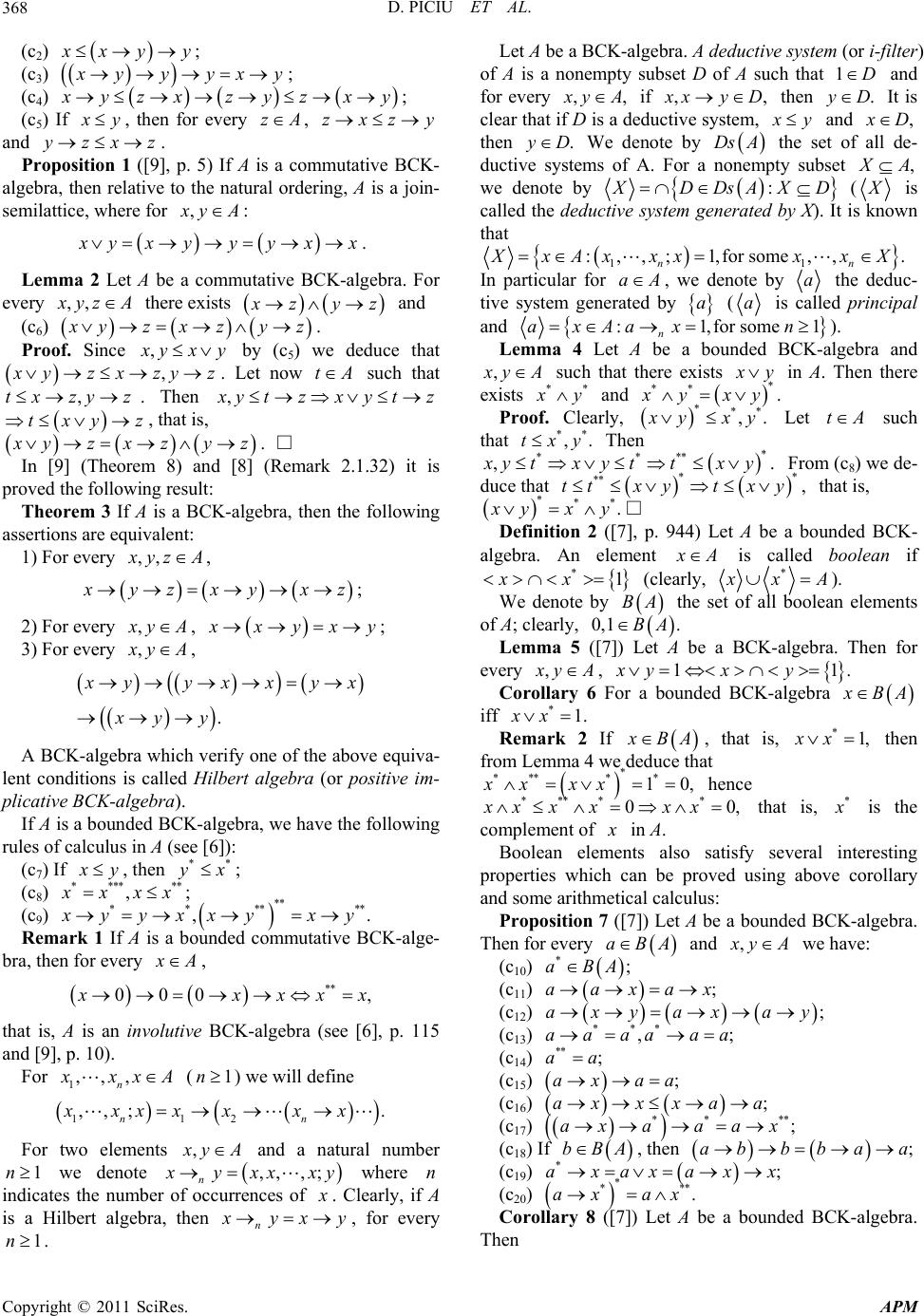 D. PICIU ET AL. 368 (c2) xy y; (c3) yy yx y ; (c4) yzxz yz xy ; (c5) If yzAzxz , then for every , and y zx z. Proposition 1 ([9], p. 5) If A is a commutative BCK- algebra, then relative to the natural ordering, A is a join- semilattice, where for , yA: yxy yyx x . Lemma 2 Let A be a commutative BCK-algebra. For every ,, yz A there exists zyz and (c6) yzx , zyz . Proof. Since yxy by (c5) we deduce that , yz ,tx zy xzyz z, . Let now such that . Then tA ytyt z z x , that is, txy z yzxzy z. □ In [9] (Theorem 8) and [8] (Remark 2.1.32) it is proved the following result: Theorem 3 If A is a BCK-algebra, then the following assertions are equivalent: 1) For every ,, yz A, yz xyxz; 2) For every , yA, xyxy ; 3) For every , yA, . yyxxy xy y x A BCK-algebra which verify one of the above equiva- lent conditions is called Hilbert algebra (or positive im- plicative BCK-algebra). If A is a bounded BCK-algebra, we have the following rules of calculus in A (see [6]): (c7) If y, then ** x ** ; (c8) **** , xx ** x; (c9) ** ** ** ,. yyxxy xy Remark 1 If A is a bounded commutative BCK-alge- bra, then for every A, ** 000 , xxx x that is, A is an involutive BCK-algebra (see [6], p. 115 and [9], p. 10). For 1,,, n xx A () we will define 1n 112 ,,; . nn xxxxx xx For two elements , yA and a natural number we denote 1n ,, ,; n yxx xy where indicates the number of occurrences of n . Clearly, if A is a Hilbert algebra, then n yxy, for every . 1n Let A be a BCK-algebra. A deductive system (or i-filter) of A is a nonempty subset D of A such that 1D and for every ,, yA if ,, xyD then . D It is clear that if D is a deductive system, y and , D then . D We denote by the set of all de- ductive systems of A. For a nonempty subset Ds A , A we denote by : DDsA XD ( is called the deductive system generated by X). It is known that 11 :, , xA ;1,for some ,, nn .x xx AxxX In particular for a , we denote by a the deduc- tive system generated by a (a is called principal and :1x,for some 1ax n n Aa ). Lemma 4 Let A be a bounded BCK-algebra and , yA such that there exists y in A. Then there exists ** y and *. ** yx *y ** ,. Proof. Clearly, yxy Let tA such that Then ** ,.txy * **** ,. yt x ** tt ** y * . t txy xyt x From (c8) we de- duce that that is, ** ,y yxy□ Definition 2 ([7], p. 944) Let A be a bounded BCK- algebra. An element A is called boolean if *1xx (clearly, * xA). We denote by BA the set of all boolean elements of A; clearly, BA0,1. Lemma 5 ([7]) Let A be a BCK-algebra. Then for every , yA , . 11xyx y Corollary 6 For a bounded BCK-algebra BA iff *1.xx Remark 2 If BA * * * 10, , that is, then from Lemma 4 we deduce that *1,xx ** * xx xx **** xx xx 0xx hence * 0, that is, * is the complement of in A. Boolean elements also satisfy several interesting properties which can be proved using above corollary and some arithmetical calculus: Proposition 7 ([7]) Let A be a bounded BCK-algebra. Then for every aBA and , yA we have: (c10) ;A * aB (c11) ;xaxaa (c12) ;x ay *** ,;aaaa aa ax ya (c13) (c14) ** ;aa (c15) ax ;aa (c16) ;xaaax x (c17) ** ax aaa ** ;x (c18) If bBA, then ;ba aab b (c19) ;axx * axax * *** .ax ax (c20) Corollary 8 ([7]) Let A be a bounded BCK-algebra. Then Copyright © 2011 SciRes. APM 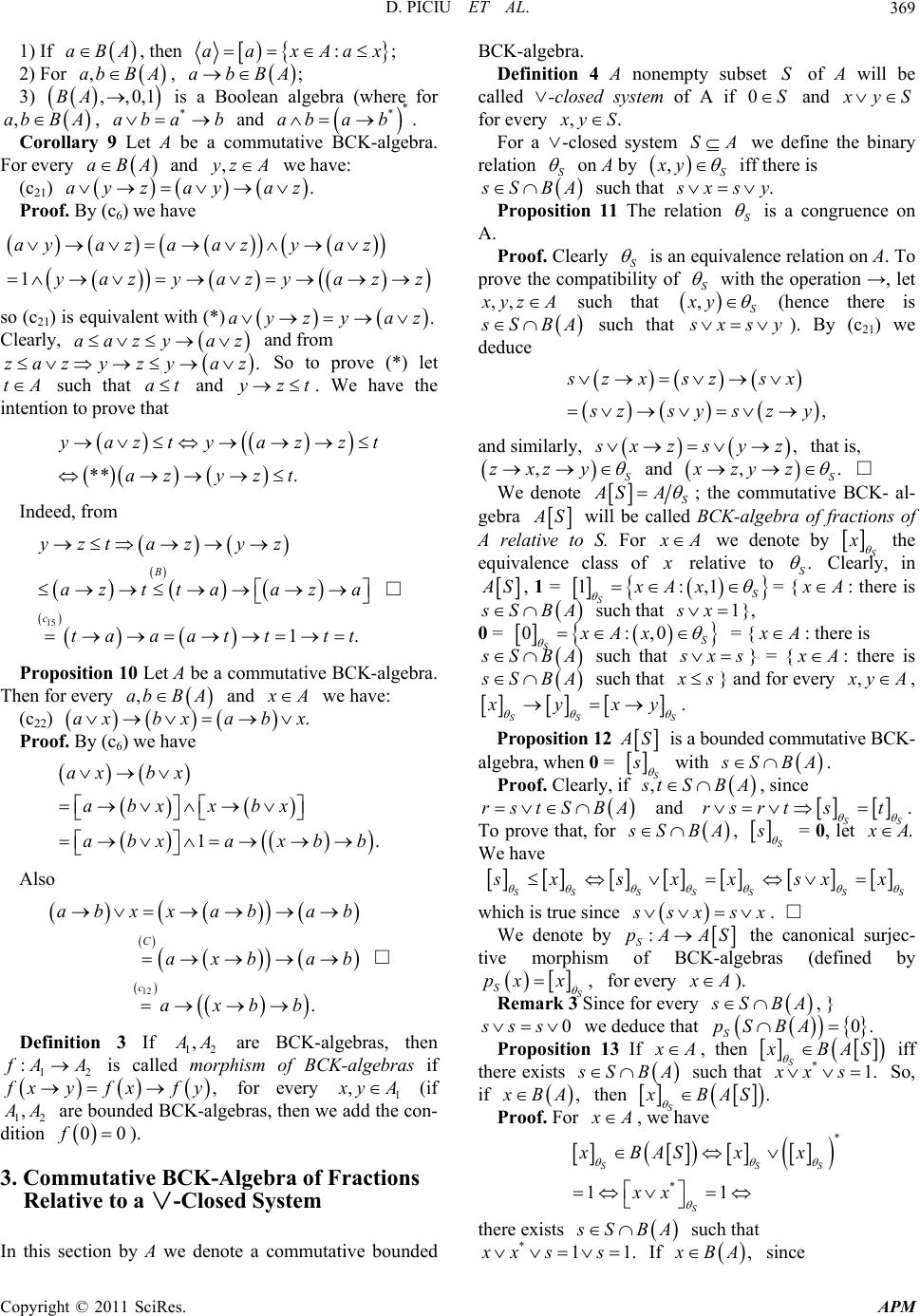 D. PICIU ET AL.369 1) If , then aBA :;aaxAax 2) For , A ,,0,1BA ,ab B ;abBA 3) is a Boolean algebra (where for , and . B Aab,ab * a b * * ab a b Corollary 9 Let A be a commutative BCK-algebra. For every and aBA, zA we have: (c21) ayz y .a az Proof. By (c6) we have 1 ayaza azyaz yazyazy azz so (c21) is equivalent with (*) .ayzy az az .az Clearly, and from So to prove (*) let such that and aazy zyzy at za tA zt. We have the intention to prove that ** . yazty azz az yzt t Indeed, from 15 1. B c yztazyz az ttaaza ta aat ttt □ Proposition 10 Let A be a commutative BCK-algebra. Then for every and ,abB A A .b x we have: (c22) ax a bx Proof. By (c6) we have 1 ax bx abx xbx abxa xbb . Also 12 . C c abxx abab axb ab axbb □ Definition 3 If 12 , A are BCK-algebras, then 12 : AA is called morphism of BCK-algebras if , xyfx fy for every 1 , yA (if 12 , A f are bounded BCK-algebras, then we add the con- dition ). 00 3. Commutative BCK-Algebra of Fractions Relative to a ∨-Closed System In this section by A we denote a commutative bounded BCK-algebra. Definition 4 A nonempty subset of A will be called ∨-closed system of A if and S S0 yS for every ,. yS For a ∨-closed system we define the binary relation SA S on A by S ,xy iff there is SBA such that . xs y Proposition 11 The relation S is a congruence on A. Proof. Clearly S is an equivalence relation on A. To prove the compatibility of S with the operation →, let ,, yz A such that S ,xy (hence there is SB A such that xs y). By (c21) we deduce , szx szsx zsyszy and similarly, , xzsyz that is, S y,zxz and xzyz,. S □ We denote S AS A ; the commutative BCK- al- gebra S will be called BCK-algebra of fractions of A relative to S. For A we denote by S the equivalence class of relative to . S Clearly, in S, 1 = ,11:xAx SS = { A: there is SBA 1 such that x}, 0 = 0:xA ,0x SS = { A: there is SBA such that xs} = { A: there is SBA such that s} and for every , yA , SS yxS y . Proposition 12 S is a bounded commutative BCK- algebra, when 0 = S with SBA . Proof. Clearly, if , tSBA, since ArstSB and .rtst S To prove that, for S rs SBA , S = 0, let . A We have SS SSSSS xsxxsxx which is true since sx sx . □ We denote by :pA AS S the canonical surjec- tive morphism of BCK-algebras (defined by , S px xS for every A). Remark 3 Since for every SBA , } we deduce that 0sss 0. S pS BA Proposition 13 If A , then S BAS iff there exists SB A such that So, if *1.xxs , BA then . S BAS Proof. For A , we have * * 11 SS S xBAS xx xx S there exists SBA 11. s such that If * xx s , BA since Copyright © 2011 SciRes. APM 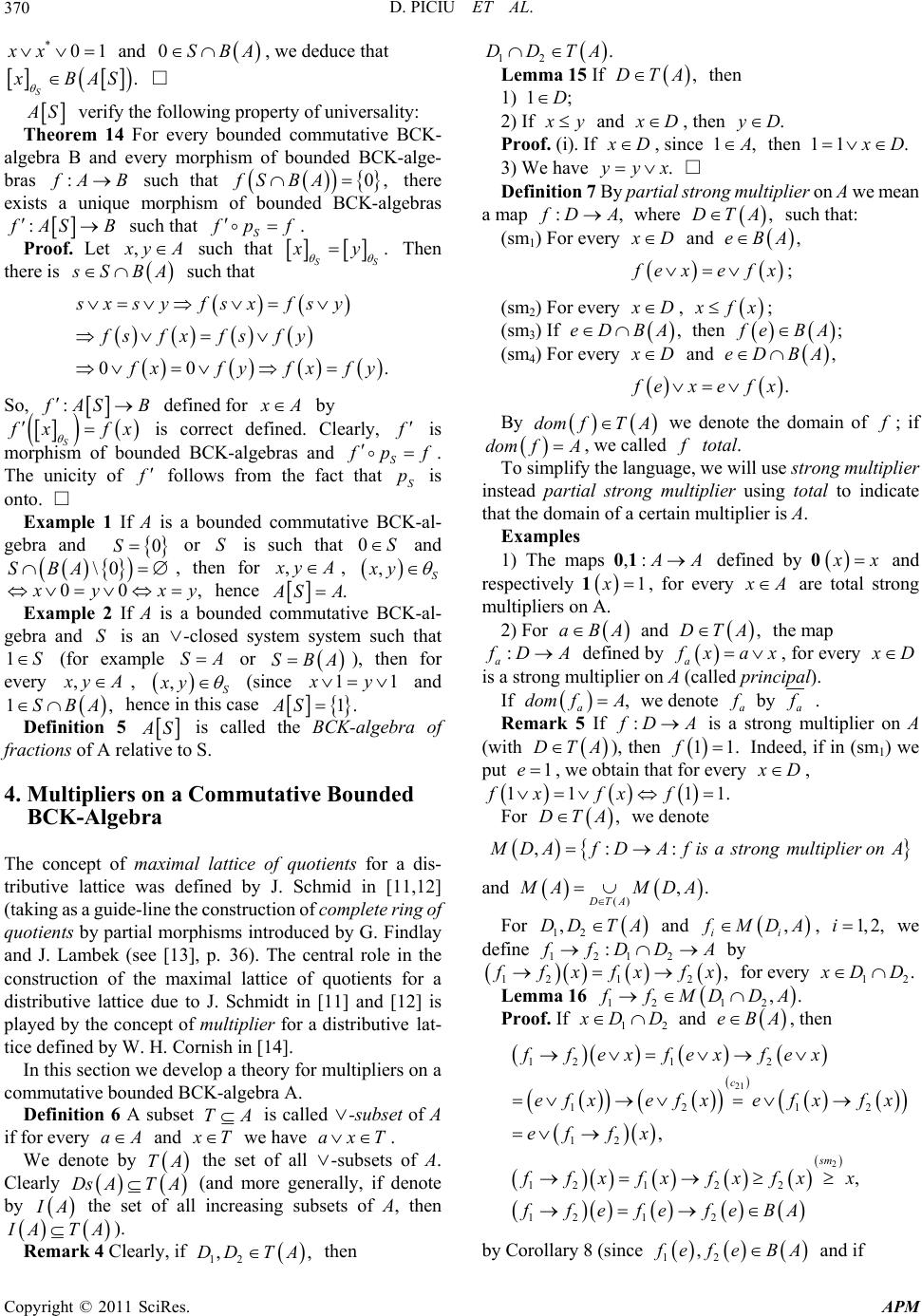 D. PICIU ET AL. 370 *01xx and 0SBA , we deduce that S . BA S □ S : verify the following property of universality: Theorem 14 For every bounded commutative BCK- algebra B and every morphism of bounded BCK-alge- bras A B such that there exists a unique morphism of bounded BCK-algebras 0,BAfS : AS B such that S pf . Proof. Let , yA such that .xy S S Then there is SBA 00 sy fsx fx fs such that x fsy fs fy . s xf yfxf y So, : AS B defined for A by S x fx is correct defined. Clearly, is morphism of bounded BCK-algebras and S pf . The unicity of follows from the fact that is onto. □ S p Example 1 If A is a bounded commutative BCK-al- gebra and 0S S or is such that 0S and , then for \0SBA , yA, ,xy S 00 , yxy hence . SA Example 2 If A is a bounded commutative BCK-al- gebra and is an ∨-closed system system such that (for example or ), then for every S 1S , SA SBA yA, ,S xy (since 11 y and hence in this case 1SBA, 1AS . Definition 5 S TA is called the BCK-algebra of fractions of A relative to S. 4. Multipliers on a Commutative Bounded BCK-Algebra The concept of maximal lattice of quotients for a dis- tributive lattice was defined by J. Schmid in [11,12] (taking as a guide-line the construction of complete r ing of quotients by partial morphisms introduced by G. Findlay and J. Lambek (see [13], p. 36). The central role in the construction of the maximal lattice of quotients for a distributive lattice due to J. Schmidt in [11] and [12] is played by the concept of multiplier for a distributive lat- tice defined by W. H. Cornish in [14]. In this section we develop a theory for multipliers on a commutative bounded BCK-algebra A. Definition 6 A subset is called ∨-subset of A if for every and aA T we have . axT We denote by TA T A the set of all ∨-subsets of A. Clearly (and more generally, if denote by Ds A A the set of all increasing subsets of A, then ATA Remark 4 ). Clearly, if 12 DD ,,TA then 12 .DTA D Lemma 15 If ,TA then D 1) 1;D D 2) If y and , then . D Proof f . (i). I D , si,nce 1 then 11 . D 3) We have .yxy □ partial strong multiplier on A we mean Definition 7 By a map :, DA where ,DTA such that: (sm1) For every D a ,A nd eB e fx; x e (sm2) For every D , fx; (sm3) If BA,eD then ; eBA (sm4) For every D and e ,DBA . e fx xe By A we denote the domain of dom fT; if do fA , we called total. the languag we wil m To simplify ins ps 0 e,l use strong multiplier ,1 tead partial strong multiplier using total to indicate that the domain of a certain multiplier is A. Examples defined by 0 x : A1) The ma and respectively 1 1x , for every A are total strong multipliers on A. 2) For aBA and the map ,DTA : a D by A defined a xax, for every D is a strong multiplier on Aipal). If (called princ , a dom fA we denote a by a . Re :mark 5 If DA is a strong multiplier on A (with DTA), then 1. Indeed, if in (sm1) we put e1f 1 , we obtain that for every D, 11 11.fx fxf For ,DTA we denote : , :DAf is aAfD and strongmultiplieronA () ,. ADT AMD A , ii MDA A 12 ,DD T, 1,2,i For and we de 12 : fine 21 fD DA by 21 , 2 1 fx fxfxevery for 12 . DD Lemma 16 1212 ,.fMDDA Proof. If 12 DD and eBA, then 21 2 1 2 121 12 2 1 2 , , c sm ex fexfex efxe fxfx fx fxfxfx x fefeBA 12 12 12 12 f f efx ef ffx ffe by Corollary 8 (since 2 12 , efe BA and if Copyright © 2011 SciRes. APM 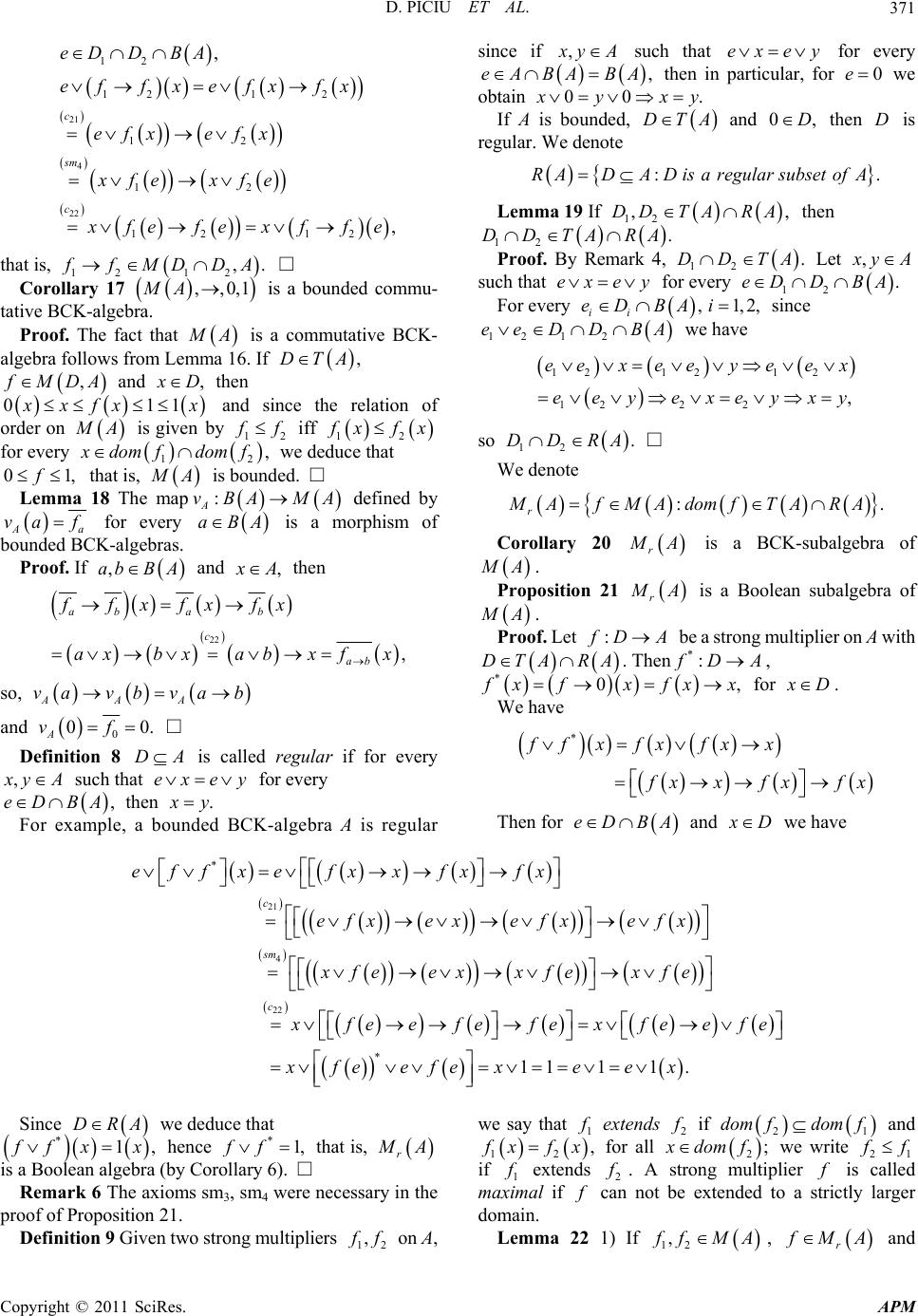 D. PICIU ET AL. Copyright © 2011 SciRes. APM 371 21 4 22 12 1 2 12 12 12 12 , , c sm c BA ef fxefx fx efx efx xfe xfe since if , yA such that for every exey ,eA ABA B then in particular, for 0e we obtain 00. yxy 12 eD D fefexffe If A is bounded, DTA and then is regular. We denote 0D,D :.RADAD isaregular subsetofA Lemma 19 If 12 ,,DD TARA then .ARA 12 DDT Proof. By Remark 4, 12 Let .ADDT, yA such that for every exey .BA 12 12 ,. fMDDA llary 17 ,,0,1MA that is, □ ounded commu- at Coro is a b tative BCK-algebra. 12 For every eDD ,BA 1, 2,i ii eD since 12 ee D 1 2 D BA we have A ma 16 Proof. The fact this a commutative BCK- algebra follows from Lem. If ,DTA , MDA and , D then 101 xf order on x and sxince the relation of A is given by 12 f iff 12 xfx for every , 12 do that is, m fdome ded 01,ff wuce that A is bou p nded. □ 18 TheLemma ma : ABAMA defined vby 12121 2 1222, eexeeyeex eey exeyxy so 12 .DDRA □ We denote :. r AfMAdomfTAR A Aa a f for every v aBA is a morphism of K-algebras. Proof. If ,abB A and Corollary 20 r A is a BCK-subalgebra of A. bounded BC , A then Proposition 21 r A is a Boolean subalgebra of A. 22 , a b c ab fxf fx axbxabx fx so, ab f x Proof. Let : DA be a strong multiplier on A with RADTA. Then*: DA, 0, * xfxfxx for D. AAA vavb vab and We have 0 00 A vf .□ finition 8 called regular if for every De is * ff xfxfxx x xfxfx DA , yA such thaey for every ,BA then t e x .eD y nded BC ple, a bouFor examK-algebra AThen for eDBA and D we have is regular 21 4 22 c sm c ef fxefxxfxfx efx exefxefx xfeexxfexfe xfe efefexfe * 1111. efe xfeefexe ex * Since we deduce that DRA 1 if 21 dom fdom fextends 2 1 we say that and 2 , 1 xfx for all 2; dom f we w21 rite f if 1 extend2 s . A srong mtultiplier is called maximal if can not to a strictly larger don. Lemma 22 1) If 12 , be extended mai fMA, r MA and *, f hence * ffx x1, that is, r A is a Boolean algebra (by Coro Remark 6 The axioms sm3, sm4 were necessary pr llary 6). □ in the oof of Proposition 21. Definition 9 Given two strong multipliers 12 , f on A, 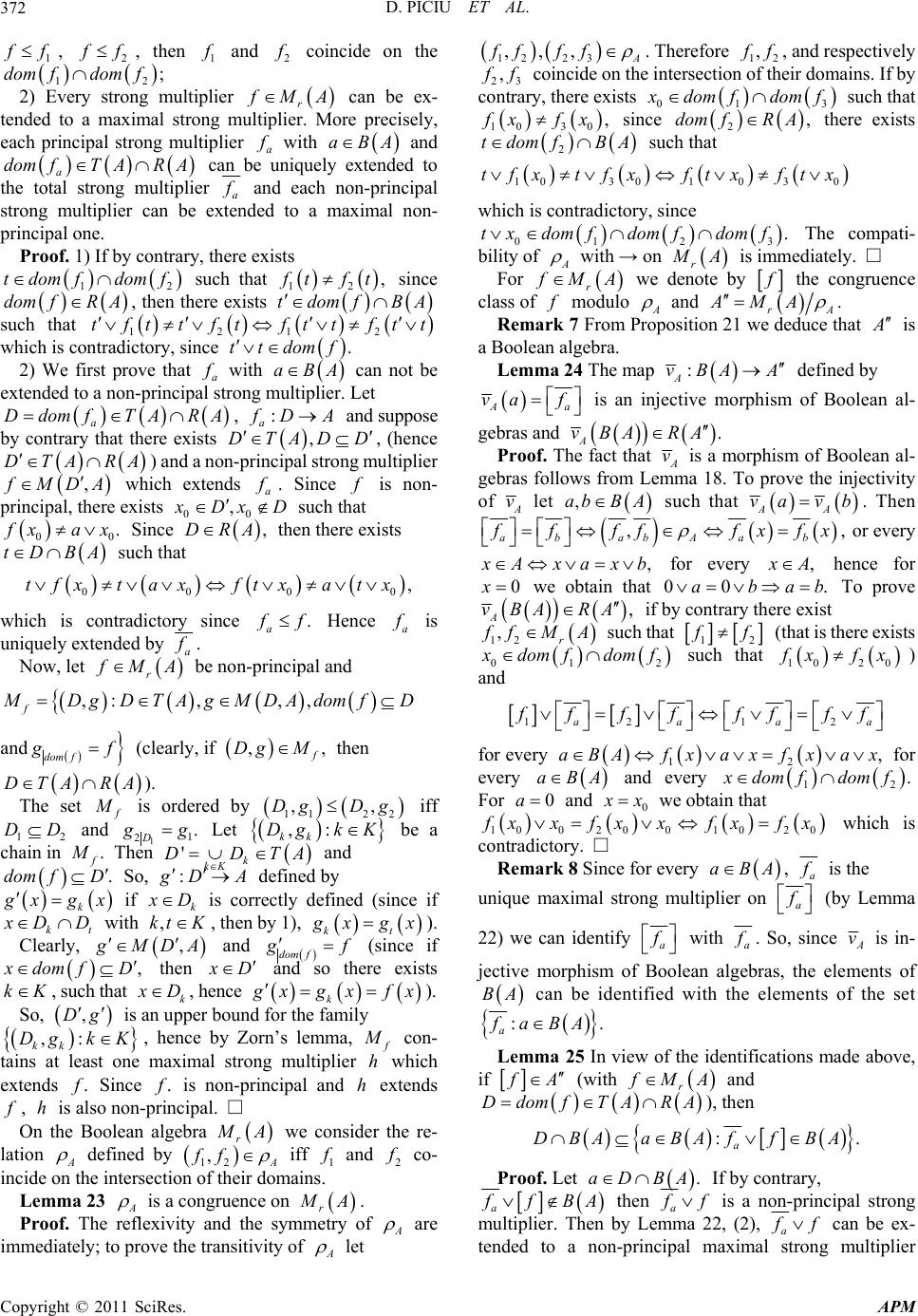 D. PICIU ET AL. 372 1 f, 2 f, then 1 and 2 coincide on the 12 ;mfdom f veg multiplier r do 2) Ery stron M ltiplier. M A can be ex- tended to ea a maximal stronmre precisely, g uo ch principal strong multiplier a with BA and a domfTAR A can be uniquely extended to the total strong multiplier a a each cipal extended to a maximal non- principal one. Proof. 1) If by contrary, there exists 1 tdomf and non-prin strong m can om ultiplier d be suc f 2 h that 12 , tft since mfR A, then there exists do BA td omf such that 12 ft tt ctory, since tt 2) We fira 12 tt f .domf tf ontradi st pr t ove t f that which is c with aBA can mu not be extended to a non-principal strong ltiplier. Let a domfTAR, : a D A DA l stro and suppose by contrary that there exists ,DTADD , ( -png multiplier , hence A R A) andDT a nonrincipa MDA which extends a . Since is non- ts 00 , principal, there exis Dx D such that 00 . xax Since ,DRAthen there exists tDBA such th 0 ,axx atx t a at x t is cont sin 000 ftf which radictoryce . f Hence a is uniquely extended by a . Now, let r MA be non-princi and : pal ,, ,, f DgM DAdom fgDT AD and fdom f (clearly, if ,, Dg M then D A). Th T e s A R et is ordered by 1122 ,,DgDg iff 12 DD and 11 2D. g Let ,: kkk K be a Dg chain in . Th en 'k kK DD .D So, TA and dom f: DA defined by k xg if xk D is correctly d(sinefined ce if kt DD with k by 1), ,tK, then kt x gx ). Clearly, , MDA and dom f f (since if , dom fD then D and ts so there exis kK, suchk that D, hence k xg xfx). n upperfor the family : k gk Kce by Zo So, ,Dg is a bound D, k, henrn’s lemma, ex co h n- tains at least one maximal strong multiplier h whic .f is non-principal and htends f, h is also non-principal. □ On the Boolean algebra r extends e .f Sinc A we consider the re- A lation defined by 12 ,ff A iff and co- in 1 2 cide on the intersection ofmains. Lemma 23 A f f their do is a on r couencengr A. Proof. The reflexivity and the symmetry of A are im f let 12 23 ,,,A ff ff . Therefore 12 ,ff, and respevely 23 ,ff coincide on the intersection of theomain 01 3 cti ir ds. If by contrary, there exists dom fm f such that do 10 30 , xfx since 2,domfR A there exists 2 tdomfB A such that 1 0 x ftxx 0 3 ft since 10 30 tfx tf which is contradictory, .m f mediately; torove the transitivity o p A 01 2 bility of A 3 f do The txdom fdom compati- with → on r A is immediately. □ For r MA we denote by the congruence class of modulo A and f A . rA MA Rem Proposition 21 weduce that ark 7 Frome d is a Booleagebra. n al Lemma 24 The map : A vBAA defined by Aa vaf injecti of Boolean al nd is anve morphism- gebras a .BA RA fact that A v he Proof. TA ma 18. ove th v is a morphism of Boolean al- gebras folloTws frome injectivity Lemo pr of A v let ,abB A ch that su AA va vb. Then , ab Aa ff fffxfx , or every abb , A, Axaxb for every hence for 0x we obtain that 00ab .ba To prove , A vBARA if by contrary tht ere exis r12 , fMA such that 12 f t (that ishere exists 201 dom fdomf such that 10 20 x fx) and 12 12aaaa ffffffff for every 12 ,aBA fxaxfxax for every aBA and every . 12 dom fdomf For 0a and 0 x we obtain that 100 20010 20 xxx f contrry. □ xfx fx which to is adic aBA, a Remark 8 Since for every i n s the unique maximal str a f ong multiplier o (by Lemma 22) we can identify a f with a . Sce o, sinA v is in- jective morphism of lean algras, the elemnts of Booebe BA can be identiwith th elements of the set fied e :.BA a fa Lemma 25 In of the identifications made above, if view A (with r MA and domfTA RA), then D .DBAaBAf BA Proof. Let : a f .aDBA If by contrary, BA then a ff a f is a non-principal strong men byultiplier. Th22, (2), Lemma a f c aximal strong multiplier an be ex- tended to a non-principal m Copyright © 2011 SciRes. APM  D. PICIU ET AL.373 : DA with .DTA Thus, DD and for every , D . a f fxfxx x fxaaf Since , then aDBA fxxfa ,fax that is, 4 sm f is principal which is contradictory with the assum tion thatp is non-principal. □ mmutative BCK-Algebra of Quotients Th section is to define (taking as a guide- ne the case of distributive lattices) the notions of BCK- 5. Maximal Co e goal of this li algebra of fractions and maximal BCK-algebra of quo- tients for a commutative bounded BCK-algebra. For some informal explanations of notions of fraction see [13] and [5]. Definition 10 A bounded commutative BCK-algebra is called BCK-algebra of fractions of A if: (f1) BA is a BCK-subalgebra of ; (f2) For every ,, ,abc Aa b , there exists suc h that aa ab an aBA d .c BA a As a notational co nvenience, we write A to in- t dicate tha is a Bf fractiCK-algebra oons of . So, A BA (since for ,,abc BA with abB , if consider ,BA then 00aa b0b and A). Definition is the tive) quo 0cc B 11 QA maximal (commuta BCK-algebra of ts of A iftien QA and for every commutative anbounded BCK-algebra d with A , there exists a monomorphism-algebras of BCK :.iAQA osition 26 Let A be a commutative and bounded uch t Prop BCK-algebra shat A . Then is a Boolean algebra. Proof. If by contrary, 6, there exists i o Corollary s not a Bolean algebra, then by A such that *1.x Since x A , then there exists eBA, such that exBA and 11.e e emma 4, ex exe * xx Then, by L *** ** ** 11 1 11 1, xex exeexx exx exx a contradiction! □ Remark 9 If A is a Boolean algebra, then .BA A By Proposition 26, QA is a Boolean alge ax bra and the ioms sm1-sm4 are equivalent with sm1, hence QA is in this case just the cal Dedekind-MacNeille com- pletion of A (see [12], p. 687). In contrast to thral situation, the Dedekind-MacNeille completion of a Boo- lean algebra is again distributive and, in fact, is a Boolean algebra (see [15], p. 239). Lemma 27 Let classi e gene A ; then for every ,,ab A ab , and any finite sequence 1n ists ,,cc ,A there ex aBA sucaa ab andh that iBA for 1, 2,,inac (n Proo lemma hol1. So we 2). for nf. Assumeds true may bBA such thatfind ba bb and i c BA for 1, 2,,1.inb Since A , we find cBA such that cb cba and b nBA ed proper cc . The cB the requirties. □ Let element abA has .aA Lemma 28 A and Then TBA : aa BABAAR . Proof. If Daa aBA, then aBA and a D and since ax aaxa B A it follows , a xDa he . To provence a BADT a DRA consider , yA such that exey, for every .A a D ntrary, eB If by co y , since A , the re exists a such that BA 0 0 aaB 0a D ) and 00 ,axay s contradictory A (that . is, □ a which i Theorem 29 (definection 4)l (commutative) BCK-algebra o ed in S is the maxima f quotients of A. QA Proof. The fact that BA is a BCK-subalgebra (Boolean subalgebra) of QA follows fromemma 2 L4 and Remark 8. To prove , QA let ,, ghQA wit ,r h , gh MA such that h (that is, there exists 0 dom gdomh such that 00 x Put hx ). domfTA R and D A [] :.BA fBA fa Then D af . DBAD by Lemma 25, If suppose that for every , aa fgfh ,BA then aD , aa fg fh ev hence forery domgdom h we have logou aa fgx fhx (anasly than as in the proof of Lemma 24) .xagx ahx axgx axh Since DRA we xhxdeduce that for every domgdom h so , h which is contradce, if ictory. Hen , h then there exists ,BAaD such that . a But for this a fg hf A we have a ffBA aDB(since [] DBAD . QA of QA ) hence To aximalityt prove the m, le be a Copyright © 2011 SciRes. APM  D. PICIU ET AL. 374 bounded commuK-algebrah that A (t2) If 12 ,DDF , then Exam 12.DDF ple 3 If tative BC suc, thus ;BA BA Then isdded i , then the set D emben QA by :iA QA defined by , a ia f fo aA aa f D (see Lemma 28). Clea r every , where dom rly, ar M obras of i, let a A (by Lemm is a mor- f BCK-algeemma 18). To prov injectivity ,,bA such that a 28) and i phism (see Le the ab ab ffxfx for every . ab DD If ,ab by Lemmce a 27 (sin A ) b BA a a b which is contradictoe b BA iab ). □ 1. If A is a BCK-algebra with nd , th nd ry (sinc aDD ere exists A such that a a ,a Remark 10 2 0,1 L a aB aa BA ,aa mplies a A 0,1 , then A hence TA D: D DTAD recall tha is a topological system on A. denote the set of all regular subsets of Example 4 Wet by RA we A (see Definition 8). Then TA RA is a topologystem on A (see Lemma 19). SA a ∨-closed subset of A (see Definition 4). I ical s Example 5 Let f we denote by :, SDTADBAFS then S is a topological system on A. is a topological system on A, l If et us consider the relation of A defined by: there exists ,F xy DF such that txty for any .tDBA As in the case of S (see Prop deduce that osition 11), we is a congruence We shall denoty on A. be 2.A L Indeed, if ,,abc A Q , with a A sat e(hence .ecBA 0,e he ,cBA th . b, then b, nce there exists eB ) and at is uch th Clearly, ae 1e x the congruence class of an ment BA Asof BCK- ras wiy we have BCK-alg hains. 2. More general, if A is a BCK-algebra such that opert examples local algeb and th this pr BCK-c ebras ele A and by : F pA A the canonical mras. 1 C orphism of BCK-algeb Remark 1learly, if . FF BA Definition 13 A aBAa -multip BA is finite, if A lier on A is a mapping then , BA hence der d consi A BA Indeed, A an.aA Q BA BA be- ing finite, there exists a smallest element eBA , then there ae a a such a e Suppose a e would exists eBA such that a ee and ut ea , a ee .aBA .eaBA B aa BA implies and thus we ob a eae a conce ,a that is . tain tradiction. Hen ,ae , ea e aBAa a e BA Then , BA hence .BA ded QA Boun e localization lattice ation otative6. Localizf BCK-ALgebras Com it mu ed th [4], G. Georgescu exhibIn L of a distributive lattice L with respect to a topology on see L in a similar way as for rings (see [16]) or monoids ( [17]). The aim of this section is to define the notion of localization BCK-algebra of a commutative bound- ed BCK-algebra A with respect to a topology on A. In the last part of this section proved that the maximal commutative BCK-algebra of quotients (defid in Sec- tion 5) and the commutative BCK-algebra of fractions relative to a ∨-closed system (defined in Section 3) are BCK-algebras of localization. In this section A will be a bounded commutative BCK-algebra and is ne a topological system on A. Definition 12 A non-empty family of elements on TA will be called a topological system on A if the following properties hold: If 12 ,DFDTA and 12 ,DD then 2 DF (hence (t1) F); : fD A where DF such that for every BA and ,a D (m1) ; F a (m) x ax f . 2Ffx , then a A-multiplier is a function ich ve only the conditions sm1 and sm2 If :Arifyf fro A wh Definitiom n 7. Theaps 0,1: m AA , defined by 0 xx and 1 1 x for every A are F-multipliers. Also, for aBA, : aF fD A de- fined by aF x aF xf for every , D is a F-multiplier (where DF ). For DF , we shall denote by , MDA t s havithe domain . If he set of all the F-multiplierng D 12 ,,DD F 12 DD we have aapping canol mnica 12 ,21 :, , DF F MDA MDA defd by ine 12 1 ,DD ff for 2,. F MDA Let us consider f the directed system of sets ,,MDAF F 12 121 2 ,,, DD DDFD D and denote by the inctive limit (in the category du of sets): li , DF m F AMDA . For any F-multiplier : fD A y we shall denote b ,Df the equivalence class of in f . Remark 12 We recall that if : i fi F D A , 1,2i multipliers, then F-are 112 2 f(in,,DfD ) iff ere exists ,DFD DD th 12 such that 12 . D ff Let :F fD A ii , (2), Fulti- with ,1,DFi ppin i pliers. Let usg -m consider the ma 1212 : ffDDA , defined by 12 1 2 , fx fxfx for any 12 , DD and let Copyright © 2011 SciRes. APM 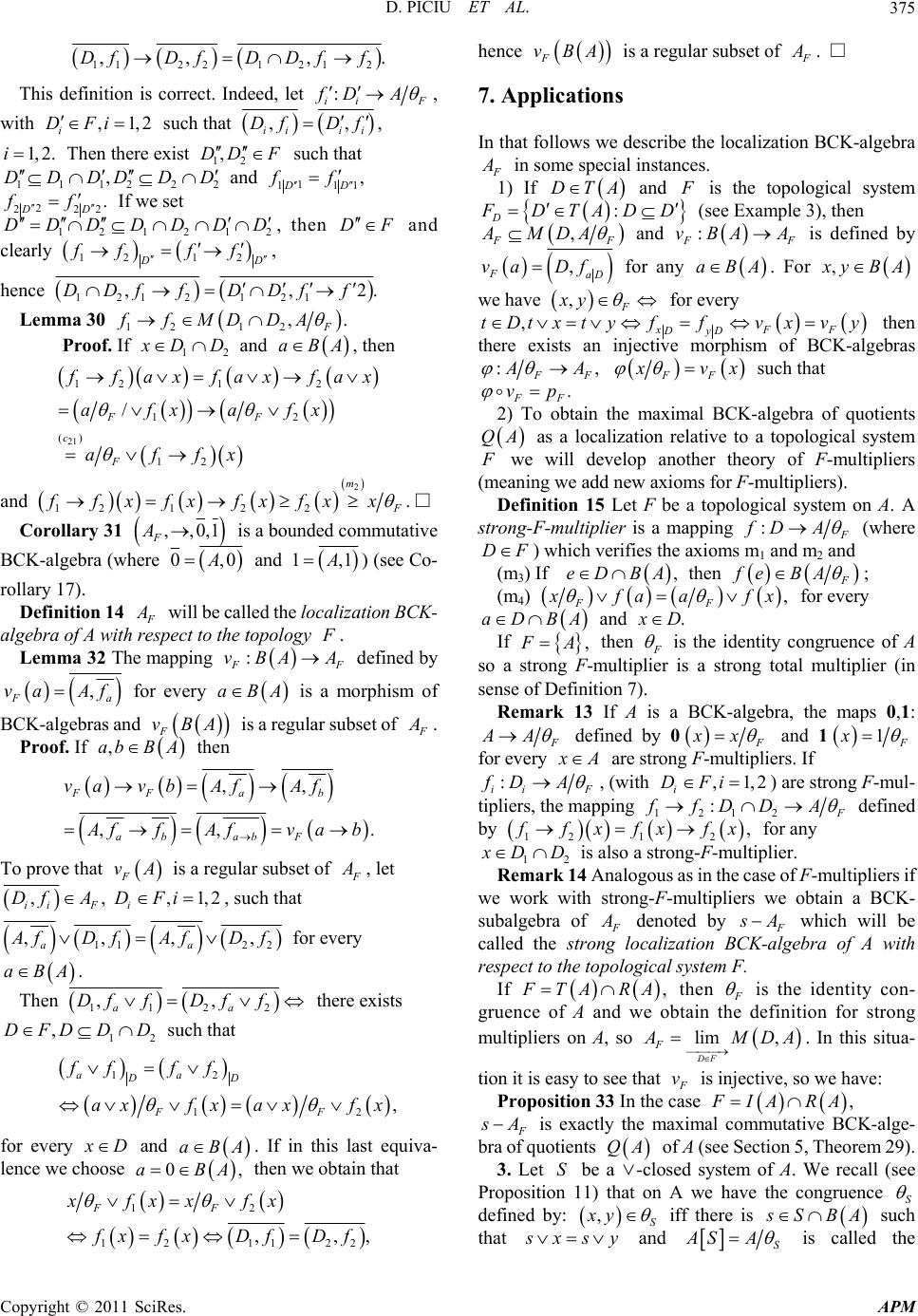 D. PICIU ET AL.375 11221212 ,, ,DfDfD Dff . This definition is correct. Indeed, let : ii F fD A , with ,1,2 i DFi such that , ii Df, ii Df , Then there such that 1, 2iexist 12 ,DD . 1 D F 2 D and 112 2 ,DDD D11 , DD 11 ff 2 222 DD 12 12 DDD DD .ff If we set 12 DD , then DF and clearly 12 12 , DD ff ff hence 121 2121 ,,DDff DDff2. ma 30Lem 12 12 ,. F ffMDDA Proof. If 12 DD and n aBA, the 21 1 () 12 / FF c F 2 12 12 fax xax f afxa affx and fa fx 2 12122. m ffxfxfxfxx □ rollary 31Co ,,0,1 F A is a bounded commutative Bre CK-algebra (whe 0,A0 and 1,1 ) (see Co- rollary 17). Definition 14 will be called the localization BCK- algebra of A with respect to the topology . Lemma 32 The mapping : F vBA deAfined by , a a Af for every orphism of v is a m BCK-algebras a is a re aBA nd F vBAgular subset of . Proof. If ,ab B A then , ,, . b ab abF v bAf, FFa v aAf ff Afvab To prove that is a regular subset of F vA , let ,, ii F Df A,1,2i, such that i DF 11 ,,, aa22 , fDfAf every Then Df for aBA. 112 2 ,, aa Df fDff there exists such that 12 DFDD,D 12 12 , aa DD FF ff axfx axfx for every ff D oose and If in this last equiva- aBA. BA lence we ch0,athen we obtain that 12FF xf fx 12 1122 ,,, xx xfxDfDf hence F vBA is a regular subset of . □ 7. Applications that follows we describe the localization BCK-algebra In in some special in 1) If stances. DTA and is the topological system : D DTADD (see Example 3), then , AF MDA and : F A AvB is defined by , FaD v , yBA aor any aBA. For Df f we have ,F xy for every ,x Dx njective m of BC FF yD tDtf v there exists an iorphism K-algebras xty f vy then :, FFF A vx such that . F vp 2) To obtain the maximal BCK-algebra of quotients QA as a locization relative tol system al a topologica we will develop another theory of F-multipliers (mDef str eaning we add new axioms for F-multipliers). inition 15 Let F be a topological system on A. A ong-F-multiplier is a mapping : fD A (where DF ) which verifies the axioms m1 and m2 and (m3) If ,eDBA then fe BA ; (m4) FF , fa a ry fx for eve BA and . D aD If , then A is the identity congruence of A so ulti is a strong tot(in sense of Defini. mark 13 a str al multiplier tion 7) ong F-m plier Re If A is a BCK-algebra, the maps 0,1: AA defined by 0 xx and 1 1 x for every A are strong F-multipliers. If : ii F D Af , (with ,1,2 i DFi ) are strong F-mul- mapping tipliers, the 1 221 : f AfDD by defined 12 1 2 , f 12 x fxfx for any DD is also a stier. Remark 14 Analog tipliers if we we obtain of rong-F-multipl ous as in the case of F-mul work with strong-F-multipliers a BCK- subalgebra denoted by A which will be called the strong localization BCK-algebra of A with respect to the topological system F. If , TA A then R is th e identity con- gruence of A and we obtain the definition for strong multipliers on A, so lim F M,DA DF tion it is easy to see that . In this situa- v is injective, so we have: Proposition 33 In t , he case IARA A is exactly theve BCK-alge- maximal commutati bra of quotients QA o (see Section 5, Theorem 2f A9). call (see Propos 3. Let S be a ∨-closed sy ition 11) that on A we have the congruence S stem of A. We re defined by: iff there is SBA such y,S x that xsy and S AS A is called the Copyright © 2011 SciRes. APM 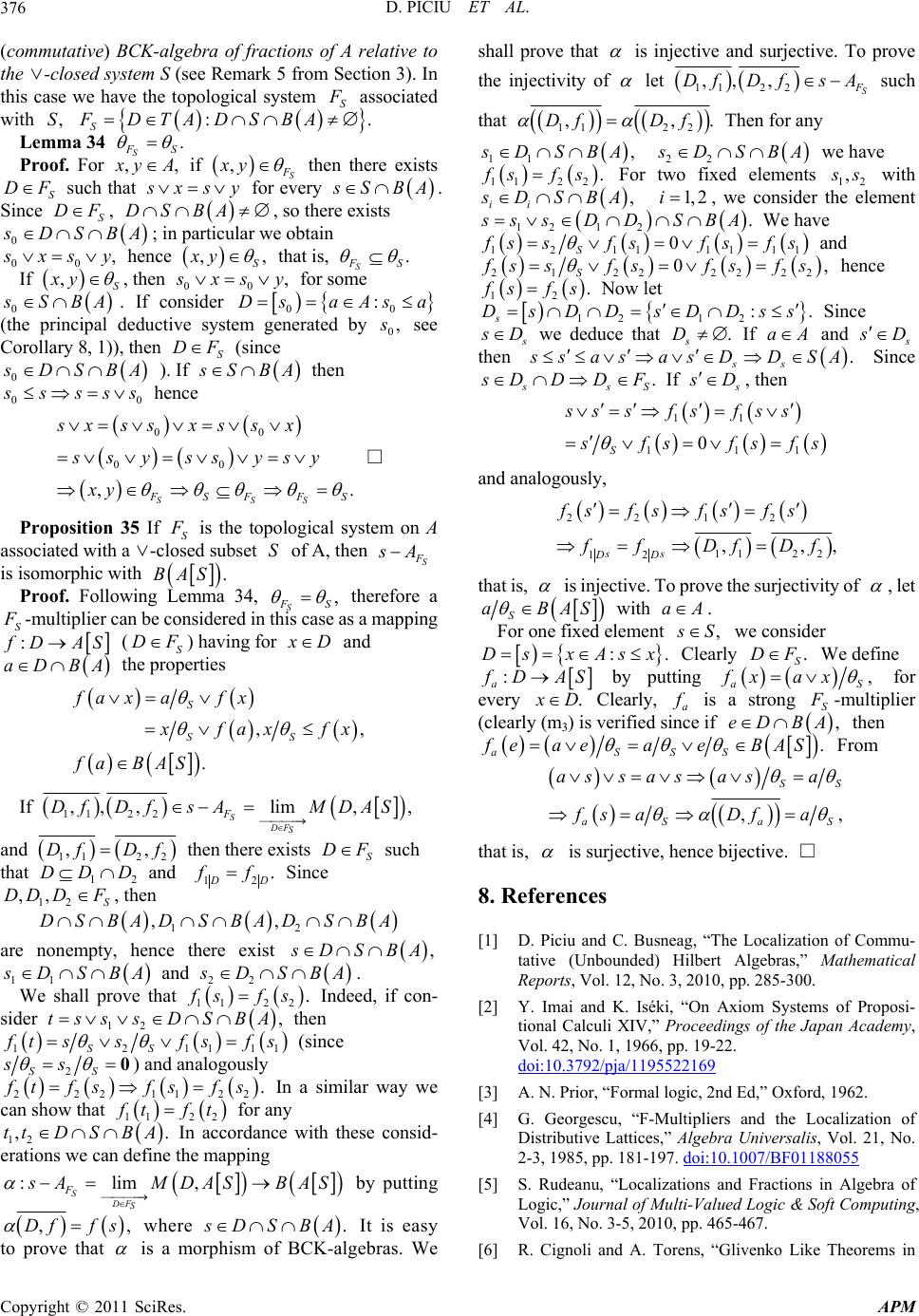 D. PICIU ET AL. 376 system S ( from Section ase we have the topological system (commutative) BCK-algebra of fractions of A relative to the ∨-closed see Remark 5 3). In this c S associated with ,S :. S FDTADSBA Lemma 34 . S S Proof. For ,, yA if ,S xy then there exists DFS such that xsy for every SBA. ts DSBA , so this Si 0 nce S DF, ere ex DSB partitain 00 , A; in cular we ob xs y hence , S ,xy that is, S. S If S ,xy , then 00 , xs y for some 0 SBA. If :A pal e system gy rinci consider 0 Ds a deductivenerated 0 sa 0, (the pb see Corollary then S DF 0 8, 1)), (since DSB A ). If S 00 BA then ssss hence 00 ,. S 00 SS SFF S ss xsx ssy ys xy sx s ssy □ tion 35 If S Proposi is the topological a ∨-closed subset S of n sy A, the stem on A associated with S A is isomorphic with .BAS Proof. Following Lemma 34, , S S therefore a S -multiplier can be considered inis case as a mg thappin : DAS (DS F) having for D and DBA the properties a S ,, . S S fa xafx fa x fa BAS If fx 112 2 ,, ,lim, SDF S F DfDfs A,AS and MD 112 2 ,,Df Df then there exists such th and S DF at 12 DDD 12 . D f Since n 12 ,,DS F, the DD 12 ,SBA DA are nonem, hence th ,SBA DBD S ptyere exist , D SBA 11 DSBA and 22 DS BA. . We shall prove that 112 2 sfsed, if con- Inde sider 12 ,tsss DSBA then 1 12111SS tss fs fs (since 2SS ss 0) and an alogously 22112 . 2 2 tn a simifsfs fs 112 2 Ilar way we can show that tft for a ,.ttSB ny with tese consid- mapping A In accordance 12 erations we can define the Dh :l im, SDF S F AM BA DAS S by putting ,,Dff s where . DSBA It is easy is a mebras. We shall prove that orphism of BC is injective and surjectiv the injectivity of e. To prove 112 2 ,, , let S DfDfs A such that 112 2 ,,.DfDf Then for any , to prove that K-alg 11 DSB A22 DSBA we have 112 2 . sfs For two fixed elements 12 , s with , ii DSBA 1,2i , we consider the element 2 . 12 1 ss A We have DD SB 0 12111111S s sfs fs fs and 222222 0, 2 1S s s henfsfs fs ce 12 . sfs Now t le ss 12 12 :.DsDD s DsD Sin ce D we deduce that . s D If aA and D then . ss sa s asDD SA Sinc . e sS DDDF If D , then 11 11 0 S ss sfsfss 1 fsfs fs and analogously, 22 12 112 2 12 ,, ss DD fs fsfs fs , fDfDf that is, is injective. To prove the surjectivity of , let SAS withaB aA . ent S For fixed elem one we consider , :.DsxAsx Clearly . S DF We define : a DAS by putting , aS fx ax for every . D Ca ilearly, s a strong S -multiplier en (clearly (m3) is verified si ,eDBA thnce if . SSSa eae a e From BAS ,, a Dfa SS aS S sas as fs a asa that is, is surjective, hence bijective. □ 8. References Pi of Commu- e (Unbounded) Hilbert thematical 2, No. 3, 2010, pp. 285-300. . Iséki, “On Axiom Systems of Proposi- [1] D. ciu and C. Busneag, “The Localization tativAlgebras,” Ma Reports, Vol. 1 ] Y. Imai and K[2 tional Calculi XIV,” Proceedings of the Japan Academy, Vol. 42, No. 1, 1966, pp. 19-22. doi:10.3792/pja/1195522169 [3] A. N. Prior, “Formal logic, 2nd Ed,” Oxford, 1962. [4] G. Georgescu, “F-Multipliers and the Localization of Distributive Lattices,” Algebra Un 2-3, 1985, pp. 181-197. iversalis, Vol. 21, No. .1007/BF01188055doi:10 ra of ems in [5] S. Rudeanu, “Localizations and Fractions in Algeb Logic,” Journal of Multi-Valued Logic & Soft Computing, Vol. 16, No. 3-5, 2010, pp. 465-467. [6] R. Cignoli and A. Torens, “Glivenko Like Theor Copyright © 2011 SciRes. APM  D. PICIU ET AL. Copyright © 2011 SciRes. APM 377 Natural Expansions of BCK-Logic,” Mathematical Logic Quarterly, Vol. 50, No. 2, 2004, pp. 111-125. doi:10.1002/malq.200310082 [7] J. Gispert and A. Torrens, “Boolean Representation of Bounded BCK-Algebras,” Soft Computing, Vol. 12, No. 10, 2008, pp. 941-954. doi:10.1007/s00500-007-0261-0 [8] A. Iorgulescu, “Algebras of Logic as BCK-Algebras,” , . J. R. Salas, “Negation and BCK- ASE, Bucharest, 2008. [9] K. Iséki and S. Tanaka, “An Introduction to the Theory of BCK-Algebras,” Mathematica Japonica, Vol. 23, No. 1 1978, pp. 1-25. [10] F. M. G. Olmedo and A Algebras,” Mathematical Logic Quarterly, Vol. 49, No. 4, 2003, pp. 336-346. doi:10.1002/malq.200310035 [11] J. Schmid, “Multipliers on Distributive Lattices ocietatis János Bolyai, 1966. o. 2, 1974, pp. and Rings of Quotients,” Houston Journal of Mathematics, Vol. 6, No. 3, 1980, pp. 401-425. [12] J. Schmid, “Distributive Lattices and Rings of Quo- tients,” Colloquia Mathematica S Vol. 33, Szeged, Hungary, 1980. [13] J. Lambek, “Lectures on Rings and Modules,” Blaisdell Publishing Company, New York, [14] H. Cornish, “The Multiplier Extension of a Distributive Lattice,” Journal of Algebra, Vol. 32, N 339-355. doi:10.1016/0021-8693(74)90143-4 [15] R. Balbes and Ph. Dwinger, “Distributive Lattices,” Uni- versity of Missouri Press, Columbia, 1974. [16] N. Popescu, “Abelian Categories with Applications to Rings and Modules,” Academic Press, New York, 1973. . [17] B. Strenström, “Platnes and Localization over Monoids,” Mathematische Nachrichten, Vol. 48, No. 1-6, 1971, pp 315-334. doi:10.1002/mana.19710480124
|